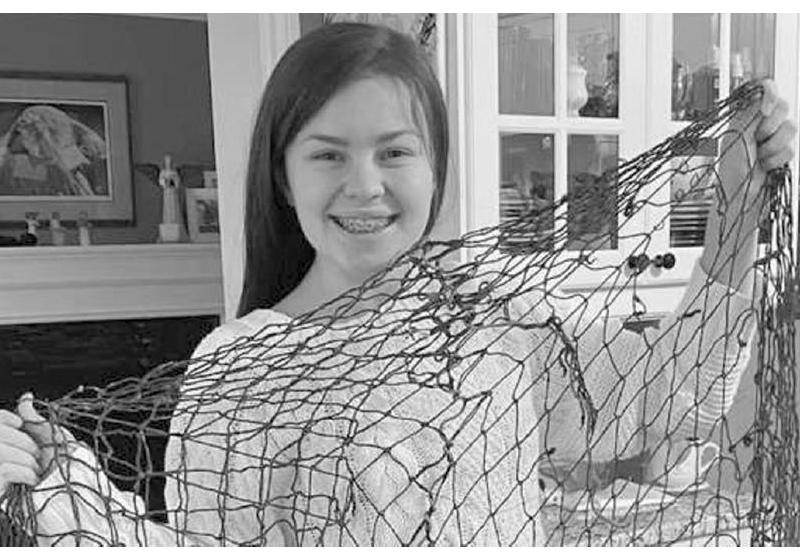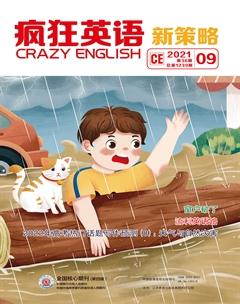Teen turns old fishing nets into artworks 少女把旧渔网变成艺术品
胡金莹


當15岁的加拿大女孩娜塔莉·麦金托什了解到丢弃在海洋中的渔网会破坏海洋环境,甚至威胁海洋生命时,她决定做一些有意义的事情来引起人们对保护海洋的重视。在家人的帮助下,她收集了废弃的渔网,并努力把它们改造成富有创意的艺术品,并因此收入颇丰。然而,这个女孩却把所有的收益都捐给了慈善机构。
An Ontario teen is making waves by turning old fishing tools into new treasures. Since last year, Natalie McIntosh, 15, has been taking lost or deserted fishing nets and rope, and transforming them into rope art, mats, bowls, baskets and necklaces. She has also been donating all of the money that she got from her non?profit business, called Nautical Waters, to charity.
Last year, Natalie was working on an assignment for her science, technology, engineering and mathematics (STEM) class. As part of the assignment, she started learning about ghost nets, which refer to the fishing nets that have been left or lost in the ocean by people who fish. “They have huge effects on our environment and they can even kill coral reefs and many animals,” said Natalie. “It seems that 46 percent of the Pacific garbage patch is covered with the ghost gear.” The Great Pacific Garbage Patch is a huge collection of trash floating in the Pacific Ocean. Natalie told her mom she wanted to do something to help.
Supported by her mother, the teen got in touch with a handful of charities, including
Emerald Sea Protection Society in British Columbia and Coastal Action in Nova Scotia. After getting some shipments of ghost nets and rope from those organizations, Natalie, with the help of her family, started turning the abandoned gear into new artworks which looked very vivid and creative. “Weve made many things, such as rope art, mats, bowls, baskets, and weve made necklaces, which also use beach glass in them,” she said.
Natalie created an artwork called “Water”, with the intention of making people recall the red sand beaches on Prince Edward Island, turning from sandy red into wavy blue. Natalie then started selling her various artworks on Etsy. Many people showed great interest in her unique works and she earned a lot of money. However, the teen donated all of her profits to the charities that in turn donated some fishing supplies to her. Natalie said she hopes to continue her passion for ocean life, with plans to study marine biology in university.
[Reading][Check]
1. Why did the young girl turn old fishing nets into artworks?
A. To raise money for the charity.
B. To set up a non?profit business.
C. To let people realize the influence of the ocean waste.
D. To create and collect special treasures.
2. What inspired the girl to do her project?
A. The homework for her course. B. A suggestion from her mother.
C. An idea from her science teacher. D. The water pollution in her community.
3. What contributes to the girls success?
A. Her bravery. B. Her creativity.
C. Her confidence. D. Her independence.
4. Where is the text probably from?
A. An advertisement. B. A biology textbook.
C. A popular magazine. D. An environmental report.
[Language][Study]
Theme?centered chunks
work on 从事;做
have huge effects on 对……有巨大的影响
be covered with 被……覆盖
get in touch with 与……取得联系
a handful of charities 一些慈善机构
with the help of 在……的帮助下
with the intention of 怀有……的意图
show great interest in 对……非常感兴趣
donate...to... 把……捐赠给……
Since last year, Natalie McIntosh, 15, has been taking lost or deserted fishing nets and rope, and transforming them into rope art, mats, bowls, baskets and necklaces. 从去年开始,15岁的娜塔莉·麦金托什就开始把遗失或废弃的渔网和绳子改造成绳子艺术品、垫子、碗、篮子和项链。

